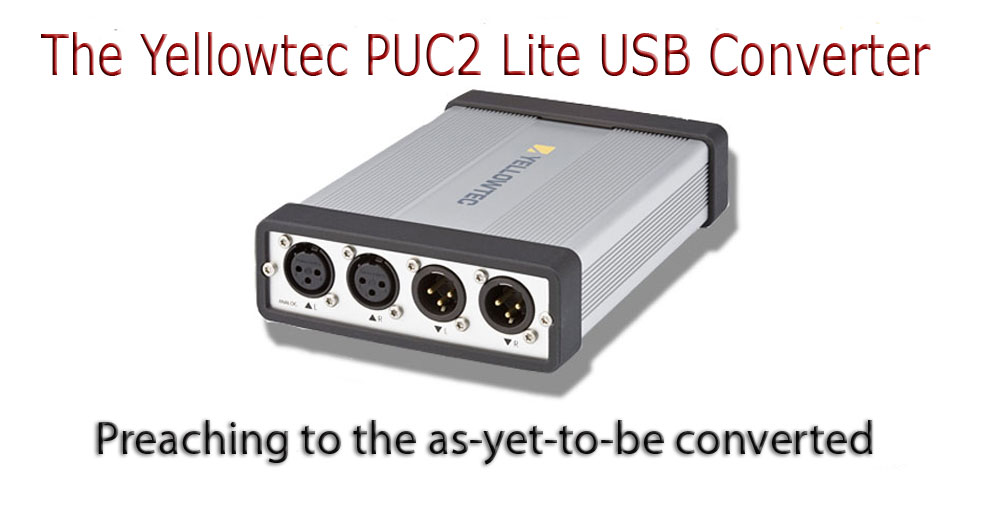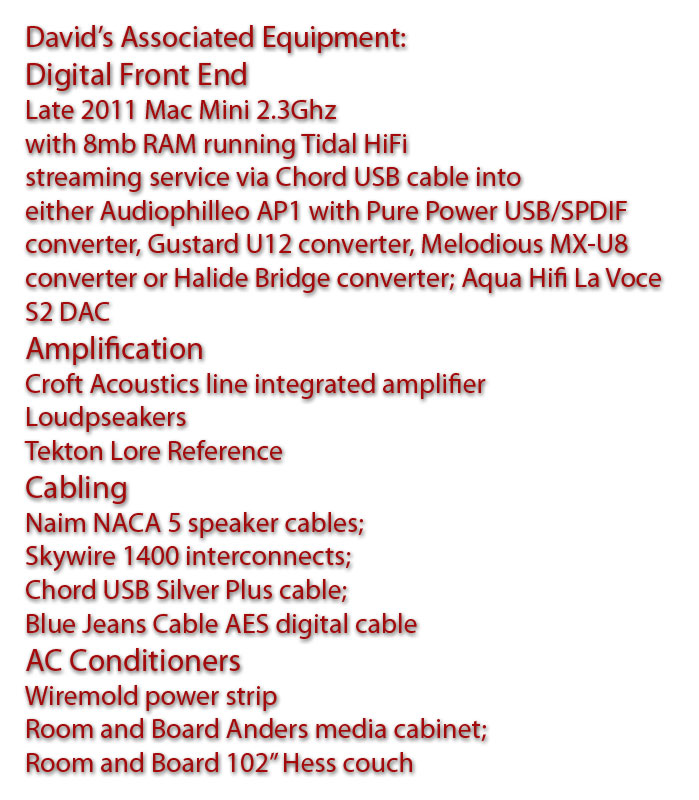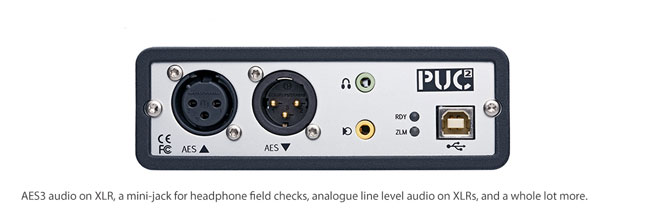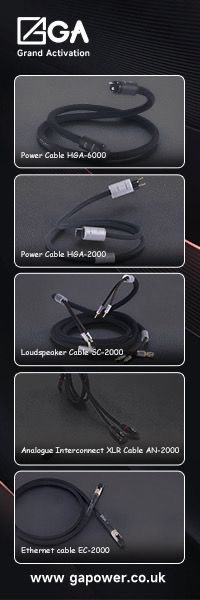Yellowtec PUC2 Lite USB Converter

 The boring-as-watching-paint-dry USB to S/PDIF converter. This small unassuming box (or set thereof if you include super-ruby-femto atomic clock/battery power supply etc.) remains an essential tool for most of us wishing to enjoy to the fullest the sonic capabilities of our computer-based music source and/or music server. Even in this day and age when we can put a man on the moon (or on a back-lot studio gussied up to look uncannily exactly like the moon), sadly- (damnably sadly), most DACs still benefit sonically from good USB to S/PDIF conversion. And this despite the valiant attempts by their manufacturers to include suitably high fidelity sonic conversion solutions as an integral part of their components’ USB inputs.
The boring-as-watching-paint-dry USB to S/PDIF converter. This small unassuming box (or set thereof if you include super-ruby-femto atomic clock/battery power supply etc.) remains an essential tool for most of us wishing to enjoy to the fullest the sonic capabilities of our computer-based music source and/or music server. Even in this day and age when we can put a man on the moon (or on a back-lot studio gussied up to look uncannily exactly like the moon), sadly- (damnably sadly), most DACs still benefit sonically from good USB to S/PDIF conversion. And this despite the valiant attempts by their manufacturers to include suitably high fidelity sonic conversion solutions as an integral part of their components’ USB inputs.
Oh sure, some of you investment banker/hedge fund manager types are saying that your ultra-high-end $20,000 DACs get it mostly right, but most of the even very good mid-tier DACs the non-hedge fund managers among us can afford do benefit from a good converter between them and their source.
As such, popular forums like Head-Fi.org and Computeraudiophile.com are rife with head to head converting and modding threads like: “this one is better than that one,” “I totally re-engineered and re-clocked that one,” and so forth.
Indeed, being that they are actual engineers or capable DIYers or both, many Head-Fiers are especially adept and knowledgeable about clock types, chip types, jitter and DIY modding of said converters. And it is by dint of this superiorly knowledgeable, technically advanced band of merry men that I came to know of and ultimately to purchase, the Gustard U12 XMOS USB converter.
Cheap, Chinese and cheerful at around $180 list, original Head-Fi poster rb2013 (probably not his real name) said it was the best of several top-flight converters he had tried, including well known and much pricier converters such as the fabled Audiophilleo 2, several of John Kenny’s, M2Tech Hiface Evo and the Musiland 3.0.
Hmmm, I thought while reading his posts (yes, I actually thought “hmmm”), I own several such well-regarded converters, all pricier than that one, and I’d enjoyed music served up through them via my Mac Mini for years now, but admittedly, never to the extent I used to with superb CD players such as my dearly departed Lectors and Naims.
Yeah, I said it. I don’t like the sound of my computer’s 0’s and 1’s as much as I did my CD players’ 0’s and 1’s. Those 0’s and 1’s that aren’t supposed to sound any different sound more digital coming from my computer; less flesh and lifeblood. Audirvana, Pure Music, Amarra; software makes no difference. Improved sonics yah, but software doesn’t quite even the score. Yep, even with a good USB converter in the mix, it’s close, but no CD (player).
C’mon, there are a lot of you out there who feel similarly and you know who you are! I don’t. But you do. Okay, but whadya gonna do?! Listen to friggin’ CDs!?? That’s bloody flippin’ heresy! The world’s moved on! Just like vinyl, CDs are dead. Dead I tells yah!! What? Vinyl is not dead!? Okay so there’s hope…
Soooo, while awaiting the CD resurrection, I’ll admit my Mac Mini is sooooo much more convenient as a music source and puts the musical world at my fingertips (not to mention HBO’s new series “Ballers” with classically trained actor Dwayne “The Rock” Johnson). Why, right this minute I’m typing this review on my iPhone on my couch listening to Quatour Ebene play Mendelssohn quartets via Tidal (the music streaming service, not the fine audio manufacturer) courtesy of said Mini. Now, I own exactly one CD of Mendelssohn’s string quartets – and this isn’t it. Also, there is the slight problem that I no longer own a CD player of any kind; not even a redoubtable Sony Playstation. So even if I did own this particular Mendelssohn CD, Jay Z is serving me up on Tidal right now, I wouldn’t be able to hear it. And my CD player never could play “Ballers.” Of course, it wasn’t on then.
Ah, all this music in computerland, and most of us by hook or by crook are forced to go USB to get it off these general purpose non-audiophiley computers and out into the world.
Yes, like you I’ve tried optical but let’s be serious here. Despite the mad musings of technical genius Rob Watts, celebrity FPGA chip-designer of Chord Hugo fame, who staunchly argues for the sonic superiority of an optical connection for digital music transmission, I’m resolutely unconvinced (yes pun intended, damn it!).
I have never heard optical outclass a good USB cable into a good USB converter into the S/PDIF input of a good DAC, period. Not once. (However, having owned Rob’s famous baby the Chord Hugo for a time, I did hear direct USB from my Mac Mini to the USB input on the Hugo outperform a converted signal into that DACs S/PDIF input. Admittedly, that was a first for me).
In the case of the now-mythical Chord Hugo, optical output sonics suffered the same fate as when I’ve tried optical with other converters in the interest of theoretically lower noise/electrically isolated transmission; slight roll off of the frequency extremes and slight diminution of musically important dynamics. No, I never tried a 500 strand $4,000 etched glass-from-the-Sistine-Chapel optical cable. And yes, I’m willing to believe it might be better. Try me.
Which brings us back to USB converters. So, as I was saying (writing), I bought the Gustard U12 32-bit XMOS converter on the recommendation of rb2013 (among others), and it was… excellent! It was definitely as advertised. It had mproved bass and dynamics, over and above my Audiophilleo, and a bit more “relaxed” sounding. Then rb2013 threw a curveball at his Head-Fi faithful, he had an affair with another converter he said greatly bettered the U12, which in turn, had bettered a lot of the “high priced” spread. He then decided to boot the U12 and move in with said new converter on a more permanent basis.
That new converter was the equally cheerful, equally Chinese (though not equally cheap at $230 USD) Melodious Audio MX-U8. Similarly capable in terms of high sample rate conversion and employing the highly regarded up-to-date programmable XMOS multicore microcontroller topology but with a more robust power supply, improved circuit isolation and perhaps more accurate digital clocks, the MX-U8 sez rb2013 was better; punchier, more detailed, weightier in the bass, bigger soundstage, the works. So I bought one. And it was! Somewhat. Not as warm/pleasant (?) as the Gustard, but slightly more detailed, forward and punchier and with a bit more expansive stage. The Gustard was good. Very good. I could actually still see preferring it in certain systems, but my preference perhaps leaned toward the not-night-and-day-better MX-U8.
Until, that is, I started experiencing random musical drop-outs with pretty much any streaming source you can name, including the one I most listen to, Jay Z’s very own Tidal! (No I don’t listen to Jay Z on Jay Z’s Tidal. I am sorry Jay Z. I know it is your Tidal) As it stands, I’m in talks, via email, with “Stacy“ in customer support in China, and their engineer is “on vacation” for a time. I wish I were kidding.
Really, I think Stacy in China’s story is suspect, because I am pretty sure the engineer is actually not on vacation now as he probably took said vacation during construction of my non-refundable $230 USD converter, or by God, somebody did!
Don’t make me come up there, China! (Down there?). You wouldn’t like me when I’m angry.

C’mon! Fix it or exchange it people! Best believe I’ll update you guys when/if something happens.
No converters anymore. I want them turned to Yellow(tec)!
(everybody now!!!)
 So just who is this Yellowtec? And what, pray tell, do they want?! And before you ask, no. I am in no way affiliated with Yellowtec. But ohhhh, I go to bed at night clutching my teddy bear soooo wishing I were. Firstly because for once, an audio company’s website precisely explains the etiology of their name: “The color yellow makes us think of words like “bright,” “optimistic” and “fun.” This is the spirit we maintain while applying our design philosophy, which is built around simplicity and perfection.” Heck, they even spell it out for you: “Yellowtec stands for “Simply Perfection.” Seems reasonable.
So just who is this Yellowtec? And what, pray tell, do they want?! And before you ask, no. I am in no way affiliated with Yellowtec. But ohhhh, I go to bed at night clutching my teddy bear soooo wishing I were. Firstly because for once, an audio company’s website precisely explains the etiology of their name: “The color yellow makes us think of words like “bright,” “optimistic” and “fun.” This is the spirit we maintain while applying our design philosophy, which is built around simplicity and perfection.” Heck, they even spell it out for you: “Yellowtec stands for “Simply Perfection.” Seems reasonable.
And secondarily, I wish I were Team Yellowtec and played on their softball team because this German professional audio equipment company manufactures one of the most sweetest game changing-est (and affordable-est!) audio products it has ever been my pleasure to hear. To wit, some components require lots of A/B-ing and head and/or beard scratching over comparatively minor sonic gains here, or a couple small sonic omissions there (USB cables I’m looking at you!) but precious few products are game changers on the order of a Tekton M-Lore or the original Burson HA-160D.
Well, I’m gonna spill it in the right here, right meow for you and tell you that for me, the Yellowtec Puc2 Lite USB to AES converter is an absolute game changer of that order. This simple little silver and black (partially rubberized) box is so musically superior to everything I’ve tried before in the realm of USB conversion – so utterly dominant – that there was nearly no need to A/B anything once I put it in my system.
In fact, I even considered making this review a Head-Fi forum post so I could thank rb2013 (what if that is his real name?) for getting me going on this journey toward my own eventual USB “conversion” and be even more lazy about Binging… errr… Yahooing (See? Neither quite work as verbs) all the technical particulars in the service of just trumpeting the Yellowtec’s merits unencumbered by any need for anything approaching enjoyable, well punctuated prose. Plus, I would’ve had the indescribable prolonged pleasure of trolls telling me I’m a fool for hearing any differences in anything digital whatsoever without a formal A/B/X test involving the Amazing Randi sitting on my lap holding a megaphone. My loss, I know.
Conversion of the rankest sort
I’m about to do something radical here, something you don’t often see in reviews but which you do see all the time on forums. Yes, I’m about to rank things in order of sonic preference. Crazy, I know!
So let’s cut to the chase here. Here’s the rank order of my stable (harem?) of converters:
1. (When it works- if it ever does again- Stacy in China please help me) Melodious MX-U8
2. Gustard U12
3. Audiophilleo AP1 with PurePower
4. Musical Fidelity vlink2
5. Halide Bridge
There it is. Done. Now wherefore is it thus? Well, first lets get one obvious glaring deficiency in my methodology out of the way. No, I did not have on hand the legendary creature of conversion, all bow down to the BADA-st converter on the planet, the Berkeley Audio Designs Alpha. Conceived in liberty and dedicated to the proposition that all converters do not convert equally (or cost $1,800), many USB converts on a plethora of forums far and wide speak (type?) its name with hushed reverence. Some do not. Some know not. Shhhhhhhhh. (Light candle now)
It did win an epic and well known, roughly fifteen converter “shootout” on computeraudiophile.com a while back, not to mention sundry awards from the audio press at-large. Then again, the Halide Bridge won a magazine shootout some years ago and it’s last on my list in the rankings, but what do I know? Se la vie. I can’t even speak French. Back to the rankings.
The Halide Bridge is too warm and lacks some detail. Patented Streamlength Asynchronous conversion methodology or no. There, I said it. The Musical Fidelity vLink2 served in honorable fashion in my main system for years before a better converter – the Audiophilleo plus PurePower – arrived. By comparison, the vLink2 has got good detail, good pace, a broad soundstage and good detail. However, I find it to be slightly grainier than I’d like. It’s not as “pure” sounding as the “purely” powered AP converter. The vLink2 even has great bass. It’s just a slight wiriness of strings and sopranos that lets down the side. The Audiophilleo converter with PurePower battery power supply on the other hand is hyper-pure. Very clean sounding with great detail and a broad soundstage and there is minimal grit and grain.
Weaknesses? In my system, as compared to the XMOS based, A/C powered U12 and MX-U8 converters, it lacks a bit of drive, bass and dynamics. So you give up a bit of punch to gain a bit of purity. Now it’s down to the Gustard v. Melodious and here, the sounds are… different. I would not say the MX-U8 walks all over the Gustard at all. Rather, the Gustard is a bit warmer and ‘glows’ a bit more (literally too as it has a digital sample rate display screen), whereas the Melodious comes across as punchier, with maybe a slightly broader stage and more detail. It’s a tad more forward sounding overall. Maybe if Stacy gets back to me about fixing it, I could even write more about the Melodious. Stacy? Stacy!!? Is the engineer back from Maui yet?

Call me Ishmael-ish
Notice the Yellowtec Puc2 Lite is conspicuously absent from the above rankings. This is because I feel the balanced output only (use a friggin’ RCA adapter if you have to!) Yellowtec Puc2 Lite deserves its own category. It is that much more musical in my particular system than those that have converted before it.
For starters, there is no edge, no grain. Zero! Digital is less digital. Ah, I can hear your mental gears churning, but I’m here (virtually) to tell you there is no roll off up top and the bass is far deeper and better defined than with the others. With the Gustard for example, the bass seems to go deeper than with the Audiophilleo, but it seems less well defined. The MX-U8 bass is deeper than the AP as well- and better defined than both converters- but does not approach that of the Yellowtec. And did I mention the treble? I’ll do it again. The Yellowtec treble is smooth, grainless, extended and defined. There is NO roll off! Here when I say the Yellowtec sounds like “great analogue,” that is very definitely not a metaphor for “rolled off top end!” The soundstage is big- at least as big as with the AP and MX-U8- maybe bigger- and easily as detailed- but filled with more dimensional, weightier images and sounds. There is more depth to the Yellowtec stage, full stop. The pace is as fast as you please, and when drum thwacks hit- they hit harder and seem to carry more complex associated harmonics instead of just punch.
Yes, the Yellowtec is just flat out more natural sounding than any other converter I’ve used, there’s no other way to say it. And in my system, it’s not a matter of inches and millimeters either. It simply pulls you in to the music and makes you miss dinner. It makes your neck and shoulders relax.
You stop thinking, “damn this is a good converter,” while listening to music right around day three (not gonna lie, day one and most of day two you really are just thinking “damn this is a good converter” most of each day as the music plays) and you just sit and listen to your music playing through your computer, as though it were music NOT playing through your computer.
That is about as high a compliment as you can give a computer/converter source. Now, I can’t tell you if this Yellowtec will beat your audio buddy’s ten grand music server or your other audio buddy’s top-flight, modded out the yin-yang, SSD breathing, linear power supplied, super Mac Mini power ranger server, but I can tell you it’s leaps and bounds ahead of any digital I’ve heard coming off my computer since I started using my computer as a dedicated music source, and that’s saying something.
Best part? It’s German! Okay, so that’s not the best part. The best part is that it retails for $480 bucks! Yep. Told ya that’s the best part. Seriously, no matter what converter is currently performing your conversion, I highly recommend you hithee to the nearest Yellowtec website and find out where you can purchase – on trial basis – your very own Yellowtec Puc2 Lite USB converter. You might just find yourself (wait for it!) right and properly… converted. I am and I was.
I bid you peace.


David Abramson
Specifications:
Yellowtec PUC2 Lite Specifications:
Inputs/outputs: 3 (XLR) inputs and outputs,
Sample rate: Up to 192 kHz at 24-bit
Dynamic range: 105dB
Accessories: PUC2 ASIO driver; split USB cable included
Dimensions: 7” x 5” x 1.6”
Weight: 1.3 lbs
Price: $485.00
Address:
THUM + MAHR GmbH
Heinrich-Hertz-Str. 1-3
D-40789 Monheim am Rhein
Germany
Website: www.yellowtec.com
Email: info@yellowtec.com
Phone: +49-2173-9673 0
Fax: +49-2173-967 400
Stereo Times Masthead
Publisher/Founder
Clement Perry
Editor
Dave Thomas
Senior Editors
Frank Alles, Mike Girardi, Russell Lichter, Terry London, Moreno Mitchell, Paul Szabady, Bill Wells, Mike Wright, and Stephen Yan,
Current Contributors
David Abramson, Tim Barrall, Dave Allison, Ron Cook, Lewis Dardick, John Hoffman, Dan Secula, Don Shaulis, Greg Simmons, Eric Teh, Greg Voth, Richard Willie, Ed Van Winkle, Rob Dockery, Richard Doron, and Daveed Turek
Site Management Clement Perry
Ad Designer: Martin Perry






Be the first to comment on: Yellowtec PUC2 Lite USB Converter